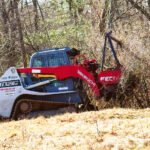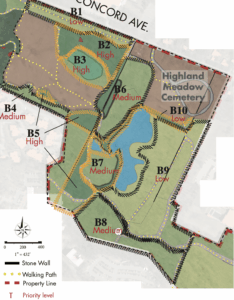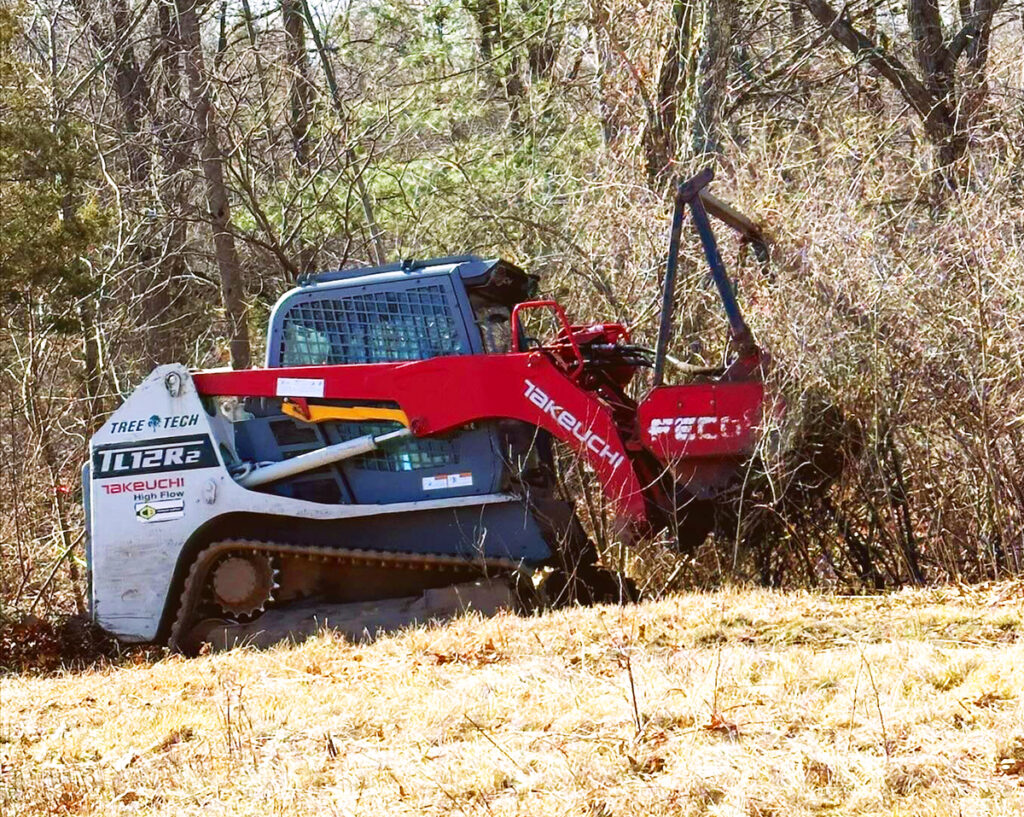
By Joseph Hibbard and Jeffrey North
A crew of 30 field technicians, crew leaders, and one or two landscape designers kicked off the Lone Tree Hill work season on Lone Tree Hill on March 14 with a day of training. For the second consecutive year, the Land Management Committee (LMC) for Lone Tree Hill (LTH) granted permission for the Parterre Ecological Services “Class of 2025” to conduct an invasive species removal training session for field technicians.
The trainees’ target area was a section in the northeast corner of the Great Meadow. The training area provided a hands-on workspace for training in plant identification, hand cutting, safe chainsaw operation, and stacking brush into habitat piles. Joseph Hibbard, Belmont resident and landscape architect, represented the LMC while guiding the work alongside Parterre staff.
The day included a review of the LTH land management plan, a discussion about site history, tool setup, instructions on debris piles that provide habitat for wildlife, herbicide signage, safety measures, seeding, and the identification of invasive and native plants in the work area. The group received training and reinforcement of prior lessons in step-by-step techniques for removing and treating invasive plants, including cutting, dabbing, girdling, and spraying.
This training exercise on LTH has produced a more capable group of field technicians, and another area of LTH (Area B2) has been cleared of invasive plant species. After initial training, Parterre divided into four teams to tackle invasive species, including common buckthorn (Rhamnus cathartica), glossy buckthorn (Frangula alnus), multiflora rose (Rosa multiflora), Asiatic bittersweet (Celastrus orbiculatus), and European privet (Ligustrum vulgare).
After cutting, the stems of these species were treated with a targeted herbicide to eliminate them at the roots, allowing native species to compete without the negative impacts of soil disturbance. Debris from the removal was stacked into intentional habitat piles that will provide cover for cottontails, nesting birds, and amphibians. Parterre work groups, trained on the site, will return to LTH at intervals during the growing season to continue the ecological restoration work that began in 2020.
Last year, during orientation and training, the team carried out an initial removal operation of invasive plants in one of the high-priority areas (B5). They removed or cut back common buckthorn, glossy buckthorn, winged euonymus (burning bush), bittersweet, and honeysuckle. Visitors to the site can see the large brush piles stacked nearby. This year, another high-priority area (B2) was addressed in a similar manner. For those familiar with the LTH conservation land back in 2020, the annual removal of invasive species since then has transformed broad areas surrounding the Great Meadow.
Restoration Plan for 2025
Parterre’s team of restoration ecologists will continue treatment with herbicides for invasive plants in the areas where the removal of invasive species began in 2020. Parterre has performed follow-up spot treatments on reemerging plants each year since then. This summer, they will schedule two visits for spot treatment in edge areas of the Great Meadow, which cover about 16 acres in the northwest corner of the LTH property and had the highest density of invasive species back in 2020. Since then, approximately 12 of the 16 acres have been successfully cleared of woody invasive plants. These clusters of oak-hickory-pine woodlands, along with meadow and meadow edge habitats, are showing renewed health due to the removal of invasive plant species.
This year will also see ongoing invasive plant herbicide treatments in the area along Judy’s Trail, named for the late Judy Record, who campaigned to save this land. Volunteers cleared this area in 2023, and Parterre has performed spot herbicide treatments in 2024, with additional treatments planned for this coming summer.
This year, new work areas include forest mowing on a slope on the south side of Lone Tree Hill along the Meadow Edge Trail. The slope was heavily overgrown with invasive glossy buckthorn, common buckthorn, and bittersweet vine. On March 19, a forestry mower produced impressive results.
On April 26, at the Belmont Citizens Forum volunteer day organized in conjunction with the Judy Record Conservation Fund, volunteers replanted the area with Eastern white pine and Eastern red cedar saplings. These evergreen trees will eventually provide shade for the bank and help suppress the regrowth of invasive shrubs and vines. Several years of follow-up monitoring for invasives on the slope will be necessary until the pines establish dominance and the desired forest growth is achieved.
The Belmont Citizens Forum and the Land Management Committee for Lone Tree Hill express our heartfelt gratitude for the ongoing support from the Judy Record Conservation Fund, which makes this vital restoration work possible.
Joseph Hibbard is a landscape architect and Belmont resident. Jeffrey North is the managing editor for the Belmont Citizens Forum Newsletter.




Sorry, the comment form is closed at this time.